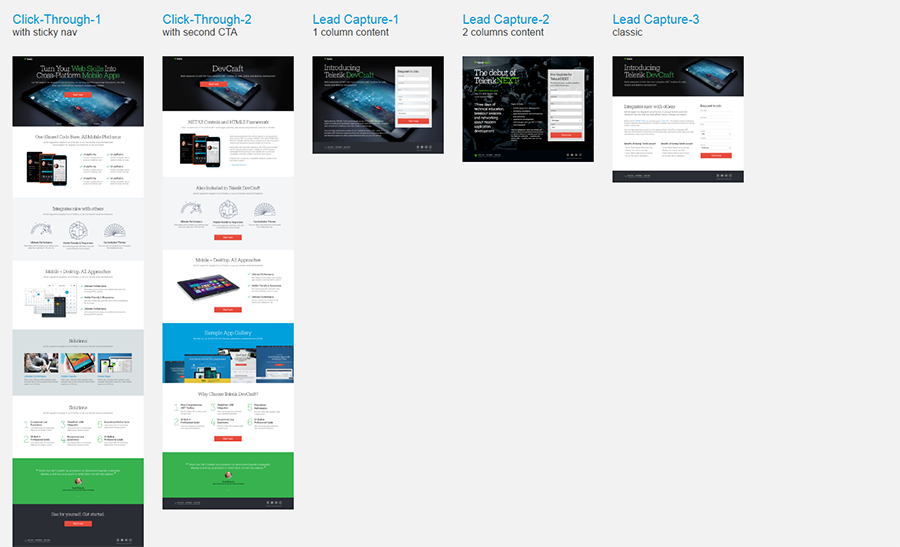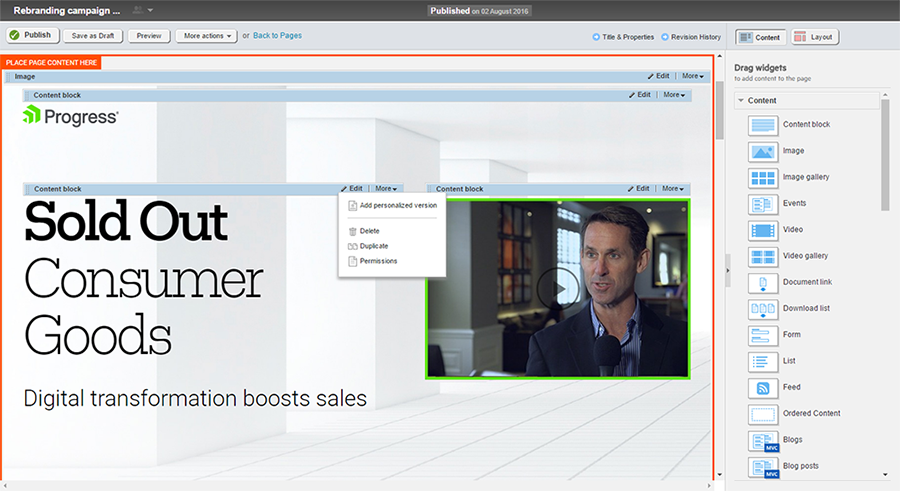Make a Rockstar Lead Gen Machine with Landing Page Templates

In business-to-business marketing, using an effective demand generation strategy is key to driving a consistent number of qualified leads and generating new revenue. In order to focus your marketing team on making their programs more effective and profitable, they need to be liberated from any technology or operational constraints.
The big obstacle to that is identifying ways to empower the team with the right technology and setup a smooth process to ensure prompt execution of your marketing plans.
Regardless of which marketing toolset and CMS you use, you need to enable your marketers to quickly and seamlessly create, setup and test any given landing page as a main touchpoint within your PPC campaign.
But how do you achieve this? Without being prescriptive, here are the steps we went through at Progress when optimizing our own campaign assets and processes:
1. Gather an Expert Team to Identify and Expedite the Landing Page Creation Process
- Gather a cross-functional team
- Research, measure, analyze
- Define and scope your use cases
To be a successful marketer today, you really need to be a “T-shaped marketer”—someone with a light level of knowledge in a broad array of skills and in-depth knowledge and expertise in one or a few disciplines. At Progress, we naturally followed this model and have an exceptional group of diverse talents, each mastering a specific area: demand generation, product marketing, marketing operations, web product management, web analytics, CRO (conversion rate optimization), personalization, UX, front-end development, etc. The challenge with larger organizations is that these people usually report to different siloed functions and all of them can be stuck in their internal processes and constraints. A simple task, such as creating a landing page for a specific campaign, can take weeks to coordinate and requires exhaustive communication between different teams and across multiple internal systems. This makes the life of a marketing expert quite difficult.
But, when you gather these people in one room and focus their creativity to achieve a very specific goal, you will be astonished at the results you might get. At Progress, we call this a “vibe” way of doing things—an agile, cross-functional group that breaks the existing rules and is not afraid to make mistakes. They work quickly, collaboratively and iteratively and are focused on achieving their business goals.
What this cross-functional team can do is conduct an audit of all your existing demand generation assets, review and analyze the top converting campaigns and determine what was different about them. Then, they can brainstorm hypotheses to determine why some specific pages performed better than others. Once they’ve done that, they will review the whole process, from the conception of the campaign to execution. This enables them to identify the steps, tools and people involved in the production of the page and brainstorm ideas to further optimize the process.
After completing this discovery phase, the team should have defined the main use cases for a successful demand generation web initiative. They should also come up with a plan for speeding up and automating the implementation process.
2. Design the Layout for Basic Templates Following Best Practices
- Define the workflows
- Create wireframes
- Test and validate
- Polish the design
Based on the findings and insights of the group, your UX team can focus on creating a predefined set of campaign page templates, with each handling a specific use case. These use cases may vary based on your business model and the type of demand generation campaigns. Externalize the templates to get feedback and approval from the different campaign managers within the organization.
Depending on the size of your company, its business model and its organizational structure, trying to standardize both the format and the process may be a challenge. Be careful not to cross the line and be too prescriptive. The page templates should align with your brand guidelines while also following the best UX and CRO practices. However, they also need to be flexible so they can be adjusted to the specifics of a particular business line and campaign goals.
There are multiple articles and guides that summarize best practices and provide advise for boosting lead generation rates. Below are a few useful links to get your creative juices flowing:
- Unbounce: 101 Landing Page Optimization Tips
- Moz: The Most Entertaining Guide to Landing Page Optimization You'll Ever Read
- Qualaroo: The Beginner's Guide to Conversion Rate Optimization—Landing Page Optimization
- HubSpot: 7 Key Design Tips for High-Converting Landing Pages
- ConversionXL: How to Build a High-Converting Landing Page—Rules, Process and Critique
Once you get approval for the main templates, it is time to involve your graphic and interaction designers to turn your low-fidelity wireframes into beautiful and engaging page templates. This is a necessary step for catching the attention of your visitors and encouraging them to fill in your forms or click through to further engage with your content and brand.

3. Develop the Predefined Layouts as Templates in Your CMS System
- Create predefined templates in the CMS
- Make templates easy to use
- Ensure compatibility with screens and browsers
- Setup a playground for experimentation
Once you have your collection of beautifully designed and branded page templates, you need to tackle the enablement and automation part. You should set up the process so that your marketing experts can easily create and fine-tune the selected templates for each specific campaign, without requiring knowledge of HTML and CSS. This way, marketing experts don’t need to rely on web developers to do their jobs.
At Progress, we are happy to use our own Sitefinity CMS, which enables the campaign manager to easily edit, preview and publish the campaign page, all without the help of a developer. The templates and drag-and-drop functionalities enable marketing experts to change the campaign creative, messaging, featured content assets and CTA labels in a matter of clicks. Marketing experts can create a brand new landing page effortlessly, all while preserving consistency and alignment with the brand design language and styles.

The web forms are also pre-built within the template and easily customized to add, remove or change input fields and labels based on the specific need or experiment.
Templates are built with responsive design capabilities as well, enabling us to target prospects regardless of whether they are visiting from a desktop computer or the latest smartphone.
4. Make Sure Your CMS is Fully Integrated with Your Digital Marketing Stack
- Identify the marketing toolset you need to integrate
- Setup the integration with the proper systems
- Automate the whole process

When I think of the challenging work required of today’s digital marketer, I remember John Cusak’s portrayal of an air traffic controller in “Pushing Tin,” an old 1999 comedy-drama. He is tasked with successfully routing flights in one of the busiest airspaces in the country—a job that comes with an enormous amount of stress and pressure.
With the vast amounts of data and the appearance of more innovative marketing tools, the marketer today has to quickly learn and adopt new systems. It’s up to you, the marketer, to make sense of all the data flowing from multiple channels, touchpoints and systems as you route leads to your sales team. At the end of the day, marketers may not be responsible for human lives, but the stress associated with constantly optimizing campaigns and keeping up with the latest practices, programs and tools so you can hit aggressive targets is unquestionable.
So, with that said, it’s vital that your CMS system is fully integrated with your marketing automation system, analytics platform, optimization tool, CRM, etc. Sitefinity CMS integrates seamlessly with the best-of-breed marketing systems. At Progress, we have done a custom integration with our in-house digital marketing stack and the data flows seamlessly across all systems—from web analytics all the way to the CRM.
5. Establish the Process Internally and Empower Marketers with Proper Training
- Create a clear step-by-step process
- Define a RACI model
- Communicate and get buy in
- Establish proper onboarding and constant training
- Inspire a culture of agility and ongoing optimization
Once the toolset is in place, you need to make it work. Clearly describe the entire lead generation process. Define goals, required actions, personnel responsibility and specific deliverables for each step of the process. Even the perfect process will not succeed if there is not a clear line between the roles and responsibilities of all the functions involved.
Setup an internal bootcamp to present the concept and new process, train current marketing professionals and ensure that new people are properly onboarded. Monitor how the whole process is executed. Seek constant feedback to improve the process and never consider it final. Processes should help organizations be more effective, not hold them down. Always remember that the business landscape is quickly evolving, so you need to change and innovate alongside it.
Copying this specific process might not help you solve all of your challenges, nor may it work perfectly your organization. But for Progress, establishing a process helped:
- Bolster marketing enablement. Empowering our marketers with the right technology helps them focus on their core competencies and functions—delivering the right message to the right customers at the right place and time.
- Reduce IT and development costs. We no longer reinvent the wheel with a whole web team of developers and designers every time we need to make a new landing page. Marketers can now focus their effort on more complex, high-value projects.
- Improve digital marketing maturity. Automating processes enables the campaign managers to focus on more strategic decisions like fine-tuning goals, using the right media mix and thinking about the next piece of content in order to optimize the CPA.
If you have similar challenges and solutions, feel free to share them.
![[a6950800-30cf-41fc-a32a-5333e00ba36e]ralitsa_peneva-headshot](https://www.progress.com/images/default-source/blogs/blog-authors/-a6950800-30cf-41fc-a32a-5333e00ba36e-ralitsa_peneva-headshot.jpg?sfvrsn=5c18287b_6)
